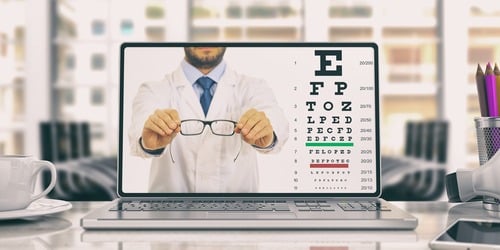What You Should Know about Getting a Glasses Prescription Online
Can you get prescription glasses without a prescription? Learn about online vision testing & things to consider before getting a glasses prescription online.
What You Should Know about Getting a Glasses Prescription Online
Jumping online to shop or complete a task is almost always more convenient than heading to a store or an in-person appointment. For individuals who require prescription eyeglasses, online vision testing and mail-order eyeglasses may seem like the next best thing.
In some instances, it can save you time and money. In other ways, it may lack in thoroughness and quality. With most vision insurance plans a deductible of $20 ($69 average for no insurance) for a full on site professional exam may worth cost for peace of mind with a person to person (doctor to patient) interaction.
If you’re considering online vision testing for a prescription, it’s important to understand how it works and what you need to consider before committing your eyes to corrective lenses that were matched online.
How to Get a Glasses Prescription Online
If you think you need a new or updated eyeglass prescription, you may be wondering if you can get prescription glasses without a prescription from an optometrist.
Online vision testing is a new medical technology that delivers eye care services via the Internet. The results of a virtual vision exam may be able to tell you what corrective eyeglasses would be best for your current vision needs. Several states have disallowed non- onsite examinations sighting safety and ethical concerns with non doctor to patient personal encounters.
It’s important to note that an online vision test will vary depending on the company you elect to take an exam through. Additionally, since you will take these exams on your computer or smartphone, your environment’s lighting and device’s stabilization can play a big role in how effective the results are.
An online vision test may assess:
- If you have blurry or stretched vision – which is a condition known as astigmatism
- The sharpness of your vision
- Your eye’s sensitivity to light
- If you have color-blindness
- Much more
Online vision tests will also require that you:
- Decide what lens material and lens coatings you need, such as polycarbonate, high-index, etc.
- How much protection from ultraviolet light you want
- Enter an exact PD (distance between your pupils) measurement
- Enter an exact head measurement, for sizing purposes
- Much more
Depending on the test you take, it may offer tips and helpful resources along the way to guide you through the exam. Some may allow you to upload a photo of yourself, so you can get a better idea of what the frame will look like on your face.
Things to Consider Before Testing Your Vision Online
1. Are you between the ages of 18 and 39?
Vision can shift more frequently under the age of 18 and above the age of 40. For this reason, online vision testing is only recommended for individuals who are 18-39 years of age with non-severe corrective eyeglass prescriptions and have no symptoms of eye disease.
2. Do you have symptoms or risk factors for eye disease?
If you are or think there is a possibility you are experiencing any vision risk factor or symptom of an eye disease, it is strongly encouraged that you seek the medical attention of an optometrist or ophthalmologist immediately. An online vision test will not assess your eye health and cannot diagnosis or catch crucial eye disease warning signs.
3. Do you have your eyes assessed in-person by a licensed optometrist every five to ten years, even if you have no symptoms or risk factors?
While online vision tests are a new wave of service and technology, any exam you take should openly suggest that adults – 18-39 years of age – who elect to take their web-based exam still need to have a comprehensive eye exam every five to ten years, even if you feel your vision is healthy. In-person eye exams are the only way to detect common, rare and/or vision-threatening eye diseases and conditions that have little or no symptoms.
4. If you already have a prescription from an optometrist, will the new eyeglasses be approved by your optometrist or opthamologist?
Regardless of the online vision test results, all eyewear prescriptions should be approved by an optometrist or ophthalmologist.
Research has found that about half of all online glasses had the wrong prescription or other problems. Purchasing and wearing the wrong prescription can lead to very uncomfortable vision, headaches, blurred vision and much more.
5. If you already have a prescription from an optometrist or ophthalmologist, do you have a high-power or irregular prescription?
Unfortunately, almost all online vision testing services do not offer high-power or irregular prescriptions. Additionally, the more complex the prescription, it’s best to always consult with your optometrist or ophthalmologist and forgo buying a prescription online.
6. Are you well-versed on the different types of lens material and lens coatings?
Science, medicine and technology have evolved to the point where there is a wide array of lens material and coatings that can accompany any prescription eyewear. Because they all offer something slightly different and are intended for certain vision issues, it’s imperative you do your research on what each lens material and coating offer. Choosing the wrong option can result in an incorrect prescription and make you eyesight worse.
7. Do you feel confident in obtaining an exact PD and head measurement?
The part of every eyeglass lens that delivers the exact vision support you need is the optical center. This center should be directly in front of your pupils. In order for your prescription glasses to align perfectly with your pupils, the eyeglass lab needs the exact distance between your pupils, or PD measurement.
While the vision test may provide a step-by-step guide on how to measure your PD, be aware that this measurement is not easy to obtain on your own. Even experienced eye doctors have difficulty taking their own PD measurement. Before you commit to a corrective eyeglass prescription obtained online, be sure the PD measurement is exact.
The head measurement is necessary to ensure the eyeglasses fit your face and head correctly. If the glasses are too tight around your head, keep slipping on the bridge of your nose, or any number of other factors, you will not feel comfortable in your glasses.
8. What is the return policy if you were to buy the recommended eyeglasses from the online vision test?
Even if everything seems to be checking out, there is always a chance that you may need to return the eyeglasses. It could be as simple as you decide you’re not completely satisfied with how they look on you. Before you commit to the purchase, be sure you will be able to return them and obtain a full refund. Some companies that offer online vision testing offer a limited return policy or don’t offer one at all.
The Best Way to Use Online Vision Testing is as a Follow-Up Tool
Ultimately, there is no substitute for a comprehensive, in-person eye exam. Online vision tests only assess vision and do not check the overall health of your eyes. This means that if you have a vision-threatening condition, such as cataracts, glaucoma, macular degeneration, floaters, retinal conditions and so on, you will not know your vision is compromised.
It should also be stated that since online vision testing is relatively new, it needs to be continuously evaluated over time to ensure safety and effectiveness.
If you have recently had an in-person eye exam by an optometrist, and they confirmed you have healthy eyes and gave you the green light to update an old prescription online, then a web-based vision test can be a beneficial service for you.
Give your eyes the best care and see an optometrist first and enjoy a peace of mind that you are getting true information from a licensed professional in person.


